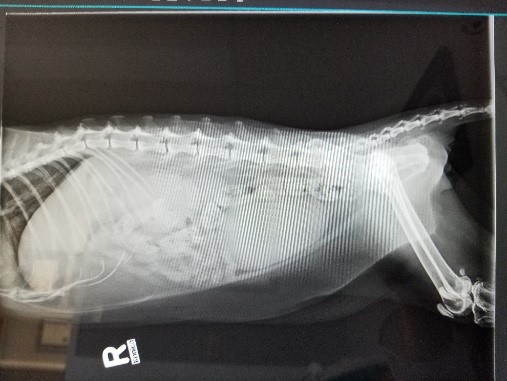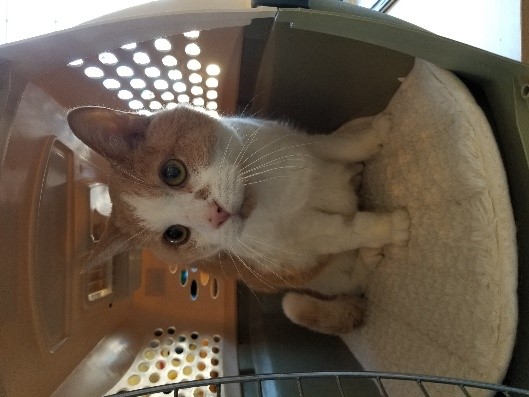Join three Ontario Veterinary College student veterinarians for the OVC Externship Blog Project as they share their experiences from the fall of 2020 completing externships in Ontario veterinary practices.
It is hard to not feel like a kid playing dress up in a doctor uniform when walking into the first day of your externship. After years of working with animals, I have the knowledge and experience I need. Now, I am expected to think like a veterinarian, to decide what diagnostic tests to perform and what treatments to recommend for each case.
My first case to work up as part of my externship was an orange and white tabby named Max. (Client consent was provided to include info and photos.) He was brought in after being seen by an emergency veterinary clinic the previous day. He was quite dehydrated and weak. I reviewed his medical  history and his bloodwork. In addition, we took a radiograph. The radiograph and bloodwork showed evidence of chronic kidney disease (CKD). The bloodwork results had elevated creatinine, which is a marker for decreased kidney function. If CKD is suspected, a urinalysis is typically performed to check for proteins, the presence of white or red blood cells, and urine concentration.
history and his bloodwork. In addition, we took a radiograph. The radiograph and bloodwork showed evidence of chronic kidney disease (CKD). The bloodwork results had elevated creatinine, which is a marker for decreased kidney function. If CKD is suspected, a urinalysis is typically performed to check for proteins, the presence of white or red blood cells, and urine concentration.
Felines with kidney disease typically present with isothenuric or minimally concentrated urine since the kidneys do not adequately function to concentrate the urine. We took a blood pressure measurement as well which showed elevated blood pressure. When the kidneys are smaller and compromised, the blood attempting to flow through the kidneys gets backed up leading to hypertension (high blood pressure). From our diagnostics, we had enough evidence to determine that Max was suffering from symptomatic chronic kidney disease.
 Managing uremia involves a number of medications. Fluids are provided to help hydrate. The fluids were supplemented with potassium. It was challenging to determine an adequate fluid dose since he has a pre-existing heart condition. GI protectants and anti-emetics keep vomiting and nausea under control. Kidney issues that result in high blood pressure require treatment. Prolonged high blood pressure can cause organ damage. Max was already on a medication that reduces blood pressure (an ACE inhibitor) for cardiac issues so that medication was continued. We needed to make sure Max was still eating so we kept offering him canned and dry food and provided an appetite stimulant. I had the opportunity to help write Max’s medical records to keep track of his diagnostic results and medications.
Managing uremia involves a number of medications. Fluids are provided to help hydrate. The fluids were supplemented with potassium. It was challenging to determine an adequate fluid dose since he has a pre-existing heart condition. GI protectants and anti-emetics keep vomiting and nausea under control. Kidney issues that result in high blood pressure require treatment. Prolonged high blood pressure can cause organ damage. Max was already on a medication that reduces blood pressure (an ACE inhibitor) for cardiac issues so that medication was continued. We needed to make sure Max was still eating so we kept offering him canned and dry food and provided an appetite stimulant. I had the opportunity to help write Max’s medical records to keep track of his diagnostic results and medications.
Follow up care for chronic kidney disease cats includes transitioning the animal to a renal diet optimized for chronic kidney disease and subcutaneous fluids. It is recommended to re-check the urinalysis, bloodwork, and blood pressure. The prognosis for animals with chronic kidney disease and clinical signs is guarded. This case was beneficial as a first case since there were several diagnostics and treatments involved. Chronic kidney disease and its management are important aspects of small animal medicine.
